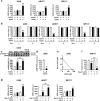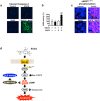Hydrogen sulphide donors selectively potentiate a green tea polyphenol EGCG-induced apoptosis of multiple myeloma cells
- PMID: 28751723
- PMCID: PMC5532223
- DOI: 10.1038/s41598-017-06879-5
Hydrogen sulphide donors selectively potentiate a green tea polyphenol EGCG-induced apoptosis of multiple myeloma cells
Abstract
Hydrogen sulphide (H2S) is a colourless gas with the odour of rotten eggs and has recently been recognized as a signal mediator in physiological activities related with the regulation of homeostasis, the vascular system and the inflammatory system. Here we show that H2S donors, including sodium hydrogen sulphide (NaHS), GYY 4137 and diallyltrisulfide (DATS), synergistically enhanced the anti-cancer effect of a green tea polyphenol (-)-epigallocatechin-3-O-gallate (EGCG) against multiple myeloma cells without affecting normal cells. NaHS significantly potentiated the anti-cancer effect of EGCG and prolonged survival in a mouse xenograft model. In this mechanism, H2S enhanced apoptotic cell death through cyclic guanosine monophosphate (cGMP)/acid sphingomyelinase pathway induced by EGCG. Moreover, NaHS reduced the enzyme activity of cyclic nucleotide phosphodiesterase that is known as cGMP negative regulator. In conclusion, we identified H2S as a gasotransmitter that potentiates EGCG-induced cancer cell death.
Conflict of interest statement
The authors declare that they have no competing interests.
Figures





References
Publication types
MeSH terms
Substances
LinkOut - more resources
Full Text Sources
Other Literature Sources
Medical

